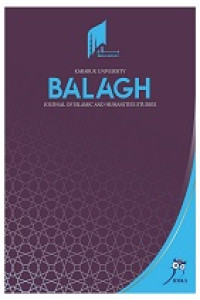Research Articles
Amaç ve Kapsam
BALAGH Journal; With scientific research, experimental, descriptive and theoretical studies, scientific articles, texts, thesis, symposiums, seminars, conferences, panels, etc. written in Arabic or English aims to contribute to science by publishing articles.
The Journal’s scope includes:
a. Revealed knowledge sciences: Tafsir and Qur’anic sciences, Hadith, Usul al-Din, Fiqh & Usul al-Fiqh, Siyasah Sharʿiyyah, etc.
b. Human sciences: Psychology, sociology, Arabic linguistics, education, history, etc., all being from an Islamic perspective.
Yazım Kuralları
1. Appearing on the first page will be: the title, names of the student and professor, names of the respective Kulliyyah and Department, and an e-mail address.
2. The article’s title and authors’ names should be written in Arabic and English atop the Abstract page.
3. Articles should include two abstracts, one in Arabic and the other in English, each being a paragraph of length 100-150 words, followed by 5 keywords for each.
4. Articles should include: an introduction, problem statement, significance of study, discussion, and findings.
5. Arabic articles should be written using the “Traditional Arabic” font, size 16, while footnotes are to be in size 14.
6. English articles should be written using the “Times New Roman” font, size 12, while footnotes are to be in size 10.
7. Articles should be 15-20 pages long, with a length of 5000 to 7000 words.
8. Citations should be numbered in a serial fashion, proceeding continuously from the first citation to the last.
9. Citations for each article should follow the Chicago Manual of Style, 16th edition. Refer to the website: http://www.chicagomanualofstyle.org/home.html
10. Citations and quotations of Qur’anic verses and Hadith in English articles should also conform to the following:
- Citations should include the author’s full name, followed by the title in italics;
if the source has been edited, all editors’ names should appear, followed by parentheses containing: City and publisher, edition, and publication date.
Volume (if applicable) and page number come next. If the source is repeatedly cited, the author’s most commonly.
-used name should be cited, followed by the source title, volume (if applicable), and page number.
- Qur’anic verses and Hadith should appear only as translations of their original Arabic texts. No Arabic texts should appear in English articles.
- Qur’anic verses should be in bold letters, followed by the chapter title and verse numbers in parentheses, and not as a footnote. See example:
Indeed, it is We Who sent down the Qur'an and indeed, we will be its guardian. [Al-Ḥijr: 9]
- Quotations of Hadith should be done directly from primary Hadith texts, taking care to classify the Hadith in terms of authenticity, if sourced from any text
other than al-Bukhāri and Muslim. Example: (The one who is proficient in the Qur’an will be with ‘al-Kirām al-Bararah’) see: Al-Bukhāri, Saḥīḥ al-Bukhārī, Kitāb al-Tawḥīd, vol. 9, p. 158.
11. All references should be in English; Arabic sources should be transliterated. Example: Ibn Ḥajar al-ʿAsqalānī, Shihāb al-Dīn Aḥmad ibn ʿAlī. (2008). Tahdhīb al- tahdhīb. Taḥqīq: Ibrāhīm al-Zaybaq, ʿĀdil Murshid. (1st edn.). Bayrūt: Mu’assasat al-Risālah.
12. Articles should be sent as word documents to the journal’s email address: balagh@karabuk.edu.tr
Etik İlkeler ve Yayın Politikası
1. All articles are to be co-authored by a student and a professor, with a short footnote description for each on the Abstract page.
2. The article should be original, not having been published elsewhere, such as another refereed journal or as a chapter in a published book.
3. The Journal is entitled to perform certain modifications to material that does not conform to its guidelines.
Ücret Politikası
BALAGH - Journal of Islamic and Humanities Studies does not charge a fee for any of the stages of publication or for any name and service. all stages and transactions are done free of charge.

